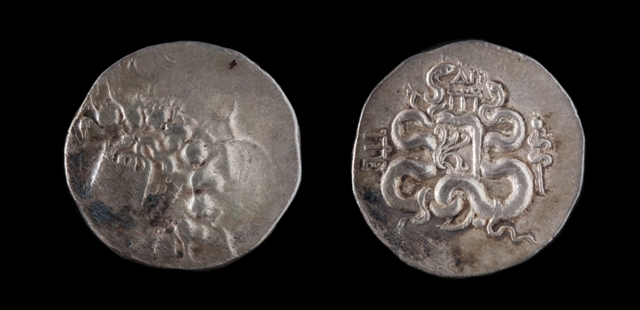Pergamon, Silver Cistophoric Tetradrachm
Dublin Core
Title
Pergamon, Silver Cistophoric Tetradrachm
Subject
Mysia (Western Turkey): Pergamon (free city in Roman Asia), Silver Cistophoric Tetradrachm, ca. 92-88 BCE.
OBVERSE: Serpent emerging from cista mystica (basket), all surrounded by ivy wreath; design worn and off-center.
REVERSE: Two serpents entwined about bow-case decorated with aplustre (the curved stern of an ancient Greek or Roman ship), PERG monogram to left, DH above, thyrsos entwined by serpent on right.
OBVERSE: Serpent emerging from cista mystica (basket), all surrounded by ivy wreath; design worn and off-center.
REVERSE: Two serpents entwined about bow-case decorated with aplustre (the curved stern of an ancient Greek or Roman ship), PERG monogram to left, DH above, thyrsos entwined by serpent on right.
Description
The Attalid King Eumenes II of Pergamon first introduced the cistophori (basketbearers), the main denomination of coinage in Asia Minor for 300 years, around 166 BCE. The last Attalid king, Attalos III, died in 133 BCE, leaving his kingdom to the Roman Empire. At the same time, he declared in his last will that Pergamon, among other important cities of his kingdom, would be “free;” meaning they would not have to pay a Roman tribute fee. Pergamon and the other cities continued to mint cistophori to honor their former ruler.
The cista mystica, shown on the obverse of this coin, is a woven basket that contains the sacred objects of a mystery cult. The worship of Dionysos was common in the east and this cista likely refers to his worship, which included a secret mystery cult. The legendary founder and first king of Pergamon was Telephos, the son of Herakles. The bow case (gorytos) on the reverse of this coin is likely a reference to this founding legend.
The cista mystica, shown on the obverse of this coin, is a woven basket that contains the sacred objects of a mystery cult. The worship of Dionysos was common in the east and this cista likely refers to his worship, which included a secret mystery cult. The legendary founder and first king of Pergamon was Telephos, the son of Herakles. The bow case (gorytos) on the reverse of this coin is likely a reference to this founding legend.
Source
Gift of James and Aneta McIntyre, Hallie Ford Museum of Art, Salem, OR. 2006.010.027
Date
133-67 BCE
Rights
Hallie Ford Museum of Arts
Format
2.680 cm
12.400 gr
12.400 gr
Type
Coin
Coverage
This item can be viewed on Hallie Ford Museum of Art's website.
Citation
“Pergamon, Silver Cistophoric Tetradrachm,” Hallie Ford Museum of Art Exhibits, accessed January 3, 2026, https://library.willamette.edu/hfma/omeka/items/show/79.
